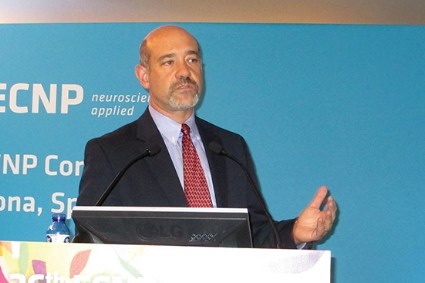User login
BARCELONA – Lanicemine, a new drug active in the glutamate neurotransmitter system, showed safety and efficacy for treating major depressive disorder during 3 weeks of treatment in a multicenter, U.S. phase II study with 152 patients.
In addition, 3 weeks of lanicemine treatment did not result in any marked psychomimetic effects such as those produced by ketamine, an anesthetic and related drug that first showed clinical antidepressant effects more than a decade ago and led to lanicemine’s testing, Dr. Gerard Sanacora said at the annual congress of the European College of Neuropsychopharmacology.
With the new lanicemine results, "I think we’re getting closer to a proof of concept that an NMDA [N-methyl-D-aspartate] receptor antagonist could be useful for development of antidepressant drugs," said Dr. Sanacora, professor of psychiatry and director of the depression research program at Yale University in New Haven, Conn.
"The results are encouraging. The study adds a lot" to addressing whether treatments targeted at the NMDA receptor can help patients with mood disorder, he said in an interview.
The study enrolled 152 patients diagnosed with major depressive disorder and poor responses to at least two antidepressants at 30 U.S. centers. While patients remained on their entry drugs, the researchers administered 100 or 150 mg lanicemine or placebo as an intravenous infusion three times a week for 3 weeks. At 3 weeks, the change from baseline in total Montgomery Åsberg Depression Rating Scale (MADRS) score, the primary endpoint, was about a 13-point decline with either dosage of lanicemine and a decline of about 8 points with placebo, a 5-point increased reduction with either lanicemine dosage that was statistically significant for each dosage.
The 100-mg dosage showed more consistent efficacy than the higher dosage. The 100-mg dosage produced significantly greater reductions from baseline, compared with placebo after 2 weeks on treatment, and also at 4 and 5 weeks after treatment began, when patients no longer received infusions. The higher lanicemine dosage did not show significant effects compared with placebo at these other time points.
Lanicemine treatment, especially the 100-mg dosage, also showed efficacy by several secondary measures. For example, the proportion of patients who recorded a clinical global impression of much improved or very much improved was 65% with the 100-mg dosage at weeks 3, 4, and 5 after treatment began, significantly better than the 25%-30% rates at the same time points in the placebo group. Dr. Sanacora and his associates also published their results online (Mol. Psychiatry 2013 [doi:10.1038/mp.2013.130]).
During the study, neither lanicemine dosage produced any clinically meaningful difference compared with placebo for dissociative symptoms, and lanicemine was generally well tolerated. The most common adverse effect was dizziness around the time of infusion, which occurred in a third to half of the lanicemine patients, compared with 12% of those on placebo. Lanicemine "looked dramatically different from ketamine," Dr. Sanacora said.
He also downplayed the barrier that treatment by infusion presents. "There is such an unmet need" for patients with severe depression who fail to respond to existing drugs that infusion is not a major issue, he said. But "several companies are trying to develop novel formulations of NMDA receptor–targeted drugs" that might be active orally or intranasally.
The study was funded by AstraZeneca, the company developing lanicemine. Dr. Sanacora said he has been a consultant to and has received research support from AstraZeneca and several other drug companies. Some of Dr. Sanacora’s associates on this study were AstraZeneca employees.
On Twitter @mitchelzoler
BARCELONA – Lanicemine, a new drug active in the glutamate neurotransmitter system, showed safety and efficacy for treating major depressive disorder during 3 weeks of treatment in a multicenter, U.S. phase II study with 152 patients.
In addition, 3 weeks of lanicemine treatment did not result in any marked psychomimetic effects such as those produced by ketamine, an anesthetic and related drug that first showed clinical antidepressant effects more than a decade ago and led to lanicemine’s testing, Dr. Gerard Sanacora said at the annual congress of the European College of Neuropsychopharmacology.
With the new lanicemine results, "I think we’re getting closer to a proof of concept that an NMDA [N-methyl-D-aspartate] receptor antagonist could be useful for development of antidepressant drugs," said Dr. Sanacora, professor of psychiatry and director of the depression research program at Yale University in New Haven, Conn.
"The results are encouraging. The study adds a lot" to addressing whether treatments targeted at the NMDA receptor can help patients with mood disorder, he said in an interview.
The study enrolled 152 patients diagnosed with major depressive disorder and poor responses to at least two antidepressants at 30 U.S. centers. While patients remained on their entry drugs, the researchers administered 100 or 150 mg lanicemine or placebo as an intravenous infusion three times a week for 3 weeks. At 3 weeks, the change from baseline in total Montgomery Åsberg Depression Rating Scale (MADRS) score, the primary endpoint, was about a 13-point decline with either dosage of lanicemine and a decline of about 8 points with placebo, a 5-point increased reduction with either lanicemine dosage that was statistically significant for each dosage.
The 100-mg dosage showed more consistent efficacy than the higher dosage. The 100-mg dosage produced significantly greater reductions from baseline, compared with placebo after 2 weeks on treatment, and also at 4 and 5 weeks after treatment began, when patients no longer received infusions. The higher lanicemine dosage did not show significant effects compared with placebo at these other time points.
Lanicemine treatment, especially the 100-mg dosage, also showed efficacy by several secondary measures. For example, the proportion of patients who recorded a clinical global impression of much improved or very much improved was 65% with the 100-mg dosage at weeks 3, 4, and 5 after treatment began, significantly better than the 25%-30% rates at the same time points in the placebo group. Dr. Sanacora and his associates also published their results online (Mol. Psychiatry 2013 [doi:10.1038/mp.2013.130]).
During the study, neither lanicemine dosage produced any clinically meaningful difference compared with placebo for dissociative symptoms, and lanicemine was generally well tolerated. The most common adverse effect was dizziness around the time of infusion, which occurred in a third to half of the lanicemine patients, compared with 12% of those on placebo. Lanicemine "looked dramatically different from ketamine," Dr. Sanacora said.
He also downplayed the barrier that treatment by infusion presents. "There is such an unmet need" for patients with severe depression who fail to respond to existing drugs that infusion is not a major issue, he said. But "several companies are trying to develop novel formulations of NMDA receptor–targeted drugs" that might be active orally or intranasally.
The study was funded by AstraZeneca, the company developing lanicemine. Dr. Sanacora said he has been a consultant to and has received research support from AstraZeneca and several other drug companies. Some of Dr. Sanacora’s associates on this study were AstraZeneca employees.
On Twitter @mitchelzoler
BARCELONA – Lanicemine, a new drug active in the glutamate neurotransmitter system, showed safety and efficacy for treating major depressive disorder during 3 weeks of treatment in a multicenter, U.S. phase II study with 152 patients.
In addition, 3 weeks of lanicemine treatment did not result in any marked psychomimetic effects such as those produced by ketamine, an anesthetic and related drug that first showed clinical antidepressant effects more than a decade ago and led to lanicemine’s testing, Dr. Gerard Sanacora said at the annual congress of the European College of Neuropsychopharmacology.
With the new lanicemine results, "I think we’re getting closer to a proof of concept that an NMDA [N-methyl-D-aspartate] receptor antagonist could be useful for development of antidepressant drugs," said Dr. Sanacora, professor of psychiatry and director of the depression research program at Yale University in New Haven, Conn.
"The results are encouraging. The study adds a lot" to addressing whether treatments targeted at the NMDA receptor can help patients with mood disorder, he said in an interview.
The study enrolled 152 patients diagnosed with major depressive disorder and poor responses to at least two antidepressants at 30 U.S. centers. While patients remained on their entry drugs, the researchers administered 100 or 150 mg lanicemine or placebo as an intravenous infusion three times a week for 3 weeks. At 3 weeks, the change from baseline in total Montgomery Åsberg Depression Rating Scale (MADRS) score, the primary endpoint, was about a 13-point decline with either dosage of lanicemine and a decline of about 8 points with placebo, a 5-point increased reduction with either lanicemine dosage that was statistically significant for each dosage.
The 100-mg dosage showed more consistent efficacy than the higher dosage. The 100-mg dosage produced significantly greater reductions from baseline, compared with placebo after 2 weeks on treatment, and also at 4 and 5 weeks after treatment began, when patients no longer received infusions. The higher lanicemine dosage did not show significant effects compared with placebo at these other time points.
Lanicemine treatment, especially the 100-mg dosage, also showed efficacy by several secondary measures. For example, the proportion of patients who recorded a clinical global impression of much improved or very much improved was 65% with the 100-mg dosage at weeks 3, 4, and 5 after treatment began, significantly better than the 25%-30% rates at the same time points in the placebo group. Dr. Sanacora and his associates also published their results online (Mol. Psychiatry 2013 [doi:10.1038/mp.2013.130]).
During the study, neither lanicemine dosage produced any clinically meaningful difference compared with placebo for dissociative symptoms, and lanicemine was generally well tolerated. The most common adverse effect was dizziness around the time of infusion, which occurred in a third to half of the lanicemine patients, compared with 12% of those on placebo. Lanicemine "looked dramatically different from ketamine," Dr. Sanacora said.
He also downplayed the barrier that treatment by infusion presents. "There is such an unmet need" for patients with severe depression who fail to respond to existing drugs that infusion is not a major issue, he said. But "several companies are trying to develop novel formulations of NMDA receptor–targeted drugs" that might be active orally or intranasally.
The study was funded by AstraZeneca, the company developing lanicemine. Dr. Sanacora said he has been a consultant to and has received research support from AstraZeneca and several other drug companies. Some of Dr. Sanacora’s associates on this study were AstraZeneca employees.
On Twitter @mitchelzoler
AT THE ANNUAL ENCP CONGRESS
Major finding: Treatment with lanicemine produced an average 5-point greater reduction in depression score from baseline, compared with placebo.
Data source: A phase II study that randomized 152 patients with major depressive disorder to either of two lanicemine dosages or placebo for 3 weeks at 30 U.S. centers.
Disclosures: The study was funded by AstraZeneca, the company developing lanicemine. Dr. Sanacora said he has been a consultant to and has received research support from AstraZeneca and several other drug companies. Some of Dr. Sanacora’s associates in the study were AstraZeneca employees.

